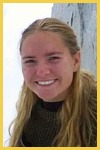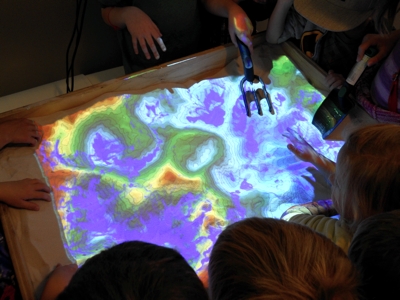
Contact Us




Department of Geology and Geophysics
1000 E. University Ave.
Laramie, WY 82071-2000
Phone: 307-766-3386
Fax: 307-766-6679
Email: geol-geophys@uwyo.edu
Profile Geological Museum and Collections Manager Laura Vietti
April 21, 2015

Geological Museum and Collections Manager Laura Vietti
Birthplace:
Golden, Colorado, but I consider Thermopolis, WY my hometown.
Doctorate:University of Minnesota, Dept. of Earth Sciences.
What did you want to be when you were growing up?I wavered between most science fields: nuclear physicist, veterinarian, doctor.
How did you get started in your field of work?It’s in my family. I’m a fourth generation Wyoming rock hound (starting with my great Aunt), and both of my parents are geologists. From as early as I can remember I’ve been learning about geology and fossils. By the time college came around, I already loved geology and it was only natural to major in it.
What motivates you to dedicate your life to the paleo sciences?I’m motivated to study paleontology, more specifically my specialty of taphonomy (paleo-forensics), because fossils not only tell us about the animals that lived in the past, but they can also help us interpret information about the past environment. For example, by looking at the size, shape, condition, associated lithology, and traces on the fossil surface, we can learn information about how long the animal was exposed before being buried, how far the remains may have traveled after death (think scavengers or river current), and we can even interpret how fast a river was moving based on the size of bones it carried. Fossils are in fact, a very information sedimentary particle!
Is there a person or experience that inspired you during your academic or professional career?I have always been passionate about taphonomy, but it was a single undergraduate seminar class, lead by Associate Professor Mark Clementz, that inspired my entire Ph.D. We were discussing a paper on the deposition of whale remains in the Miocene of Peru, and it sparked a conversation about how rarely paleontologists take ‘bloat and float,’ the phenomena that most whale carcasses float for weeks to months before sinking to the seafloor, into account when discussing the paleogeography of fossil marine mammals. From that point onward it has been a fascination of mine to account for post-death transportation of remains in paleo-geographic reconstructions.
Also, working as a Peace Corps. volunteer in Honduras ultimately led me to pursuing an advanced degree in paleontology. As a volunteer, I had the opportunity to work with and help educate folks and I liked it so much that I knew I wanted to dedicate my life to teaching and working with the public.
What has been your favorite experience in the field? The most challenging?My most memorable experience in the field was when I was doing an actualistic taphonomic experiment off the coast of the San Salvador, Bahamas. As part of the experiment, I placed defleshed pig ribs on the ocean floor, but it didn’t occur to me that the bones would also attract sharks. So in the process of deploying one of my experiments I was actively pursued by a white-tipped reef shark. Thankfully the beach was close and I could swim fast enough.
How are you enjoying your return to Laramie and Wyoming so far?I am enjoying being back in Laramie so much and for so many reasons. I really like being back in a ‘small’ town (big for Wyoming, small compared to Minneapolis), where the people are incredibly friendly. I also really enjoy seeing mountains and the sun almost every day. It is also great to be closer to friends and family, as well as be able to escape to the country and go rock collecting in less than 20 minutes.
What are some of your other hobbies and passions?Rock/Fossil collecting is my favorite thing to do! Another hobby of mine, especially in the winter, is stained glass.
Tell us a little bit about your plans for the Geological Museum. What can visitors look forward to in the coming months and years?
Kids can’t get enough of the Augmented Reality Sandbox—the newest addition to the
UW Geological Museum. The Augmented Reality Sandbox uses an infrared sensor to capture
sand topography, the elevation data is then used by a program to project topographic
contour lines and elevation colors back onto the sand in real time.
I love the Geological Museum and am reminded daily how much of an honor it is to manage it. A major goal of mine for the museum is to better incorporate and highlight research done by the UW Geology and Geophysics faculty into the museum displays. A second goal is to provide more reasons for folks to visit the museum by: providing more interactive displays, changing displays more frequently, and developing weekly or monthly programs for all ages. In the next few months, visitors can look forward to two new exciting museum developments. First we are installing the permanent version of the Augmented Reality Sandbox. Kids and adults love the display, so we are making it bigger and more easily accessible. If you haven’t seen it yet, it’s worth a visit into the museum. Secondly, we are starting to redesign our temporary exhibit space. Currently, we have a great installment on T-Rex, but by May we hope to have a new exhibit featuring landscape change across multiple time scales, and how we interpret landscape change in the past.
How can people get involved and stay up to date with the latest museum activities?The Museum Facebook’s page (www.facebook.com/uwgeomuseum) or the museum website (www.uwyo.edu/geomuseum) are great places to look. Soon we will also invite folks to become members of the museum and as part of the member fee’s you’ll get personal invites to many of our activities. Lastly, we hope to launch a new version of the museum newsletter sometime during the Spring 2015 semester, which will provide information and calendars of museum activities and events.
Last question. Does Triceratops deserve its place as Wyoming’s state dinosaur? If not, which dinosaur should take it’s place?Good question! Many Triceratops specimens have been discovered in Wyoming, including one of the most compete specimens to date. However, I think a much better candidate would be Allosaurus or Camarasaurus (since we have A LOT! Of them), or Supersaurus, Wyoming’s largest dinosaur.
Contact Us




Department of Geology and Geophysics
1000 E. University Ave.
Laramie, WY 82071-2000
Phone: 307-766-3386
Fax: 307-766-6679
Email: geol-geophys@uwyo.edu
